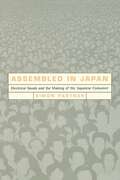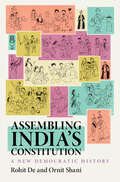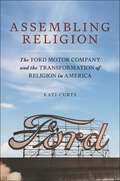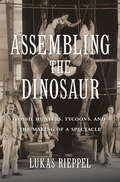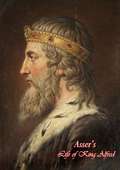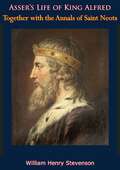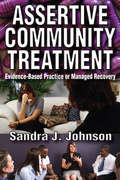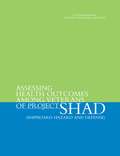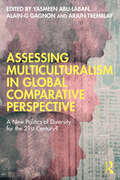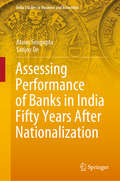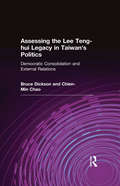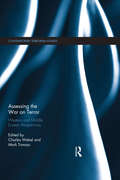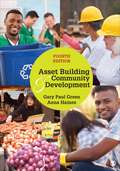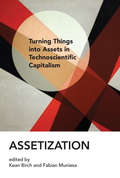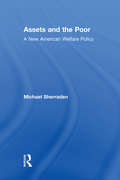- Table View
- List View
Assembled in Japan: Electrical Goods and the Making of the Japanese Consumer
by Simon PartnerAssembled in Japan investigates one of the great success stories of the twentieth century: the rise of the Japanese electronics industry. Contrary to mainstream interpretation, Simon Partner discovers that behind the meteoric rise of Sony, Matsushita, Toshiba, and other electrical goods companies was neither the iron hand of Japan's Ministry of International Trade and Industry nor a government-sponsored export-led growth policy, but rather an explosion of domestic consumer demand that began in the 1950s.This powerful consumer boom differed fundamentally from the one under way at the same time in the United States in that it began from widespread poverty and comparatively miserable living conditions. Beginning with a discussion of the prewar origins of the consumer engine that was to take off under the American Occupation, Partner quickly turns his sights on the business leaders, inventors, laborers, and ordinary citizens who participated in the broadly successful effort to create new markets for expensive, unfamiliar new products.Throughout, the author relates these pressure-cooker years in Japan to the key themes of twentieth-century experience worldwide: the role of technology in promoting social change, the rise of mass consumer societies, and the construction of gender in advanced industrial economies.
Assembling India’s Constitution: A New Democratic History
by Ornit Shani Rohit DeIn this paradigm-shifting history, two leading historians of India re-examine the making of the Indian constitution from the perspective of the country's people. In a departure from dominant approaches that foreground the framing of the text within the Constituent Assembly, Ornit Shani and Rohit De instead demonstrate how it was shaped by diverse publics across India and beyond. They reveal multiple, parallel constitution-making processes underway across the subcontinent, highlighting how individuals and groups transformed constitutionalism into a medium of struggle and a tool for transformation. De and Shani argue that the deep sense of ownership the public assumed over the constitution became pivotal to the formation, legitimacy and endurance of India's democracy against arduous challenges and many odds. In highlighting the Indian case as a model for thinking through constitution making in plural societies, this is a vital contribution to constitutional and democratic history.
Assembling Religion: The Ford Motor Company and the Transformation of Religion in America
by Kati CurtsHow Henry Ford institutionalized a social gospelHenry Ford did not just mass produce cars. As a member of the Episcopal Church, reader of New Thought texts, believer in the “gospel of reincarnation,” mass marketer of antisemitic material, and employer who institutionalized a social gospel, Henry Ford’s contributions to American models of business were informed by and produced for an America he understood to be broadly Christian. Though Ford’s efforts at the head of the Ford Motor Company have commonly been understood as secular, Ford himself was explicit that his work in engineering and auto production was prophetic and meant to remake the world.This religious history of Henry Ford and the Ford Motor Company repositions them within critical studies of religion, examining how Ford transformed American religious practice in the twentieth century. Drawing directly on documents from Ford’s archive, it examines Ford’s mass production methods and bureaucratic reforms as examples of prosperity gospel traditions, illuminating the ways manufacturing and technology intersect with American religious practice. Bridging American religious and industrial history, Assembling Religion offers a new and surprising way to understand Ford’s impact on culture, commerce, and the technology of labor.
Assembling Tomorrow: A Guide to Designing a Thriving Future from the Stanford d.school (Stanford d.school Library)
by Scott Doorley Stanford d.school Carissa CarterA powerful guide to why even the most well-intentioned innovations go haywire, and the surprising ways we can change course to create a more positive future, by two celebrated experts working at the intersection of design, technology, and learning at Stanford University&’s acclaimed d.school.&“This brilliant book offers a new approach to all creative work that will expand your understanding of what it means to make and open up possibilities you didn&’t know existed—it did for me.&”—Adam Johnson, Pulitzer Prize-winning author of The Orphan Master&’s SonIn Assembling Tomorrow, authors Scott Doorley and Carissa Carter explore the intangible forces that prevent us from anticipating just how fantastically technology can get out of control, and what might be in store for us if we don&’t start using new tools and tactics. Despite our best intentions, our most transformative innovations tend to have consequences we can&’t always predict. From the effects of social media to the uncertainty of AI and the consequences of climate change, the outcomes of our creations ripple across our lives. Time and again, our seemingly ceaseless capacity to create rubs up against our limited capacity to understand our impact. Assembling Tomorrow explores how to use readily accessible tools to both mend the mistakes of our past and shape our future for the better. We live in an era of &“runaway design,&” where innovations tangle with our lives in unpredictable ways. This book explores the off-kilter feelings of today and follows up with actionables to alter your perspective and help you find opportunities in these turbulent times. Mixed throughout are histories of the future, short pieces of speculative fiction that imagine the future as if it has already happened and consider the past with a critical yet hopeful eye so that all of us—as designers of our own futures—can create a better world for generations to come.
Assembling the Dinosaur: Fossil Hunters, Tycoons, and the Making of a Spectacle
by Lukas RieppelLukas Rieppel shows how dinosaurs gripped the popular imagination and became emblems of America’s industrial power and economic prosperity during the Gilded Age. Spectacular fossils were displayed in museums financed by North America’s wealthiest tycoons, to cement their reputation as both benefactors of science and fierce capitalists.
Assembling the Dinosaur: Fossil Hunters, Tycoons, and the Making of a Spectacle
by Lukas RieppelA lively account of the dinosaur’s role in Gilded Age America, examining the connection between business, paleontology, and museums.Although dinosaur fossils were first found in England, a series of dramatic discoveries during the late 1800s turned North America into a world center for vertebrate paleontology. At the same time, the United States emerged as the world’s largest industrial economy, and creatures like Tyrannosaurus, Brontosaurus, and Triceratops became emblems of American capitalism. Large, fierce, and spectacular, American dinosaurs dominated the popular imagination, making front-page headlines and appearing in feature films.Assembling the Dinosaur follows dinosaur fossils from the field to the museum and into the commercial culture of North America’s Gilded Age. Business tycoons like Andrew Carnegie and J. P. Morgan made common cause with vertebrate paleontologists to capitalize on the widespread appeal of dinosaurs, using them to project American exceptionalism back into prehistory. Learning from the show-stopping techniques of P. T. Barnum, museums exhibited dinosaurs to attract, entertain, and educate the public. By assembling the skeletons of dinosaurs into eye-catching displays, wealthy industrialists sought to cement their own reputations as generous benefactors of science, showing that modern capitalism could produce public goods in addition to profits. Behind the scenes, museums adopted corporate management practices to control the movement of dinosaur bones, restricting their circulation to influence their meaning and value in popular culture.Tracing the entwined relationship of dinosaurs, capitalism, and culture during the Gilded Age, Lukas Rieppel reveals the outsized role these giant reptiles played during one of the most consequential periods in American history.Praise for Assembling the Dinosaur“A penetrating study of legitimacy and capitalism in the realm of fossils.” —Verlyn Klinkenborg, The New York Review of Books“A solid entry into the growing body of literature on Gilded Age American paleontology, but it is particularly valuable for its contribution to enhancing our understanding of how science and its representation during that period were influenced by, and in turn affected, society as a whole. By incorporating cultural, economic, and scientific developments, Rieppel shines new light on the history of both American paleontology and museum exhibition practice.” —Ilja Nieuwland, Science
Assembling the Tropics: Science and Medicine in Portugal's Empire, 1450–1700 (Studies in Comparative World History)
by Hugh CagleFrom popular fiction to modern biomedicine, the tropics are defined by two essential features: prodigious nature and debilitating illness. That was not always so. In this engaging and imaginative study, Hugh Cagle shows how such a vision was created. Along the way, he challenges conventional accounts of the Scientific Revolution. The history of 'the tropics' is the story of science in Europe's first global empire. Beginning in the late fifteenth century, Portugal established colonies from sub-Saharan Africa to Southeast Asia and South America, enabling the earliest comparisons of nature and disease across the tropical world. Assembling the Tropics shows how the proliferation of colonial approaches to medicine and natural history led to the assemblage of 'the tropics' as a single, coherent, and internally consistent global region. This is a story about how places acquire medical meaning, about how nature and disease become objects of scientific inquiry, and about what is at stake when that happens.
Assembly by Design: The United Nations and Its Global Interior (Buell Center Books in the History and Theory of American Architecture)
by Olga TouloumiHow the United Nations headquarters became the architectural instrument and broadcast medium of global diplomacy For almost seven years after World War II, a small group of architects took on an exciting task: to imagine the spaces of global governance for a new political organization called the United Nations (UN). To create the iconic headquarters of the UN in New York City, these architects experimented with room layouts, media technologies, and design in tribunal courtrooms, assembly halls, and council chambers. The result was the creation of a new type of public space, the global interior. Assembly by Design shows how this space leveraged media to help the UN communicate with the world. With its media infrastructure, symbols, acoustic design, and architecture, the global interior defined political assembly both inside and outside the UN headquarters, serving as the architectural medium to organize multilateral encounters of international publics around the globe. Demonstrating how aesthetics have long held sway over political work, Olga Touloumi posits that the building framed diplomacy on the ground amid a changing political landscape that brought the United States to the forefront of international politics, destabilizing old and establishing new geopolitical alliances. Uncovering previously closed institutional and family archives, Assembly by Design offers new information about the political and aesthetic decisions that turned the UN headquarters into a communications organism. It looks back at a moment of hope, when politicians, architects, and diplomats—believing that assembly was a matter of design—worked together to deliver platforms for global democracy and governance.
Asser's Life of King Alfred
by AsserAlfred the Great (848 - 899) was a king in West Saxon and then the first king of the Anglo-Saxons, king of Britain. He spent his early career fighting Viking invasions, until in 878 he won a decisive victory against them, and then personally oversaw the conversion of the Viking leader to Christianity. He left a legacy for being gracious, rational, peaceable, and generally working to improve the overall quality of people's lives. This biography was composed by Asser (d. 909), a Welsh monk and later bishop.-Print ed.
Asser's Life of King Alfred, Together with the Annals of Saint Neots
by William Henry StevensonAsser (died c. 909) was a Welsh monk from St David's, Dyfed, who became Bishop of Sherborne in the 890s. About 885 he was asked by Alfred the Great to leave St David's and join the circle of learned men whom Alfred was recruiting for his court. After spending a year at Caerwent because of illness, Asser accepted.In 893 Asser wrote a biography of Alfred, called the Life of King Alfred. The manuscript survived to modern times in only one copy, which was part of the Cotton library. That copy was destroyed in a fire in 1731, but transcriptions that had been made earlier, together with material from Asser's work which was included by other early writers, have enabled the work to be reconstructed. The biography is the main source of information about Alfred's life and provides far more information about Alfred than is known about any other early English ruler. Asser assisted Alfred in his translation of Gregory the Great's Pastoral Care, and possibly with other works.
Assertive Community Treatment: Evidence-based Practice or Managed Recovery
by Sandra JohnsonThe twenty-first century has witnessed an explosion in studies on comparative health studies, but mental health remains virtually ignored. Unlike the well researched topic of health policy, there is a gap in the marketplace covering mental health policy and health care policymaking. This book fills that gap; it is a comparative analysis of the implementation of Assertive Community Treatment (ACT), an evidence-based practice employed in two states that promises to empower the well-being of individuals suffering from mental illness.Assertive Community Treatment specifically examines the tension separating the notion of client recovery and evidence-based programs. Johnson challenges the assumption that practitioners should rely on evidence-based practices to close the gap between scientific knowledge and practice. She argues that in an era of managed care, this encourages state mental health administrators to adopt policies that are overly focused on outcomes. Programs that can measure the outcomes of care provided, and evidence-based practices, have become central aspects of the quality care agenda.This study traces the role of policy entrepreneurs throughout the Assertive Community Treatment policymaking process. By differentiating mental health in general, qualitative research increases the chances of observing similarities and differences in outcomes. Johnson explains why the ACT model was adopted and implemented. She concludes that there is a clear monopoly by medical researchers and scientists within Assertive Community Treatment research, and as a result, too much emphasis is placed on the roles of policy entrepreneurs as the main innovators in the agenda and policy formulation stages. Johnson presents a strong argument for more innovation in the implementation stage.
Assessing China's Naval Power: Technological Innovation, Economic Constraints, and Strategic Implications (Global Power Shift)
by Sarah KirchbergerThis book analyzes the rise of China's naval power and its possible strategic consequences from a wide variety of perspectives - technological, economic, and geostrategic - while employing a historical-comparative approach throughout. Since naval development requires huge financial resources and mostly takes place within the context of transnational industrial partnerships, this study also consciously adopts an industry perspective. The systemic problems involved in warship production and the associated material, financial, technological, and political requirements currently remain overlooked aspects in the case of China. Drawing on first-hand working experience in the naval shipbuilding industry, the author provides transparent criteria for the evaluation of different naval technologies' strategic value, which other researchers can draw upon as a basis for further research in such diverse fields as International Security Studies, Naval Warfare Studies, Chinese Studies, and International Relations.
Assessing Health Outcomes Among Veterans of Project SHAD (Shipboard Hazard and Defense)
by Engineering Medicine National Academies of SciencesBetween 1963 and 1969, the U.S. military carried out a series of tests, termed Project SHAD (Shipboard Hazard and Defense), to evaluate the vulnerabilities of U.S. Navy ships to chemical and biological warfare agents. These tests involved use of active chemical and biological agents, stimulants, tracers, and decontaminants. Approximately 5,900 military personnel, primarily from the Navy and Marine Corps, are reported to have been included in Project SHAD testing. In the 1990s some veterans who participated in the SHAD tests expressed concerns to the Department of Veterans Affairs (VA) that they were experiencing health problems that might be the result of exposures in the testing. These concerns led to a 2002 request from VA to the Institute of Medicine (IOM) to carry out an epidemiological study of the health of SHAD veterans and a comparison population of veterans who had served on similar ships or in similar units during the same time period. In response to continuing concerns, Congress in 2010 requested an additional IOM study. This second study expands on the previous IOM work by making use of additional years of follow up and some analysis of diagnostic data from Medicare and the VA health care system.
Assessing Maritime Disputes in East Asia: Political and Legal Perspectives (Contemporary Issues in the South China Sea)
by Barthélémy Courmont, Frédéric Lasserre and Éric MottetCombining practical and theoretical approaches, this book addresses the political, legal and economic implications of maritime disputes in East Asia. The maritime disputes in East Asia have multiplied over the past few years, in parallel with the economic growth of the countries in the region, the rise of nationalist movements, fears and sometimes fantasies regarding the emergence of the People’s Republic of China (PRC) as a global power, increasing military expenses, as well as speculations regarding the potential resources in various disputed islands. These disputes, however, are not new and some have been the subject of contention and the cause of friction for decades, if not centuries in a few cases. Offering a robust analysis, this volume explores disputes through the different lenses of political science, international law, history and geography, and introduces new approaches in particular to the four important disputes concerning Dokdo/Takeshima, Senkaku/Diaoyu, Paracels and Spratlys. Utilising a comparative approach, this book identifies transnational trends that occur in the different cases and, therefore, at the regional level, and aims to understand whether the resurgence of maritime disputes in East Asia may be studied on a case by case basis, or should be analysed as a regional phenomenon with common characteristics. This book will be of interest to students of Asian Politics, Maritime Security, International Security, Geopolitics and International Relations in general.
Assessing Maritime Power in the Asia-Pacific: The Impact of American Strategic Re-Balance (Corbett Centre for Maritime Policy Studies Series)
by Greg Kennedy Harsh V. PantLeading academics from around the world, who specialize in analysing maritime strategic issues, deliberate the impact of the American 'pivot' or 're-balance' strategy, and the 'Air-Sea Battle' operational concept, on the maritime power and posture of a number of selected states. Intending to strengthen US economic, diplomatic, and security engagement throughout the Asia-Pacific, both bilaterally and multilaterally, the re-balance stands out as one of the Obama administration's most far-sighted and ambitious foreign policy initiatives.
Assessing Multiculturalism in Global Comparative Perspective: A New Politics of Diversity for the 21st Century?
by Yasmeen Abu-Laban, Alain-G Gagnon and Arjun TremblayIn Assessing Multiculturalism in Global Comparative Perspective, a group of leading scholars come together in a multidisciplinary collection to assess multiculturalism through an international comparative perspective. Multiculturalism today faces challenges like never before, through the concurrent rise of populism and white supremacist groups, and contemporary social movements mobilizing around alternative ideas of decolonization, anti-racism and national self-determination Taking these challenges head on, and with the backdrop that the term multiculturalism originated in Canada before going global, this collection of chapters presents a global comparative view of multiculturalism, through both empirical and normative perspectives, with the overarching aim of comprehending multiculturalism’s promise, limitations, contemporary challenges, trajectory and possible futures. Collectively, the chapters provide the basis for a critical assessment of multiculturalism’s first 50 years, as well as vital insight into whether multiculturalism is best equipped to meet the distinct challenges characterizing this juncture of the 21st century. With coverage including the Americas, Europe, Oceania, Africa and Asia, and thematic coverage of citizenship, religion, security, gender, Black Lives Matter and the post-pandemic order, Assessing Multiculturalism in Global Comparative Perspective presents a comprehensively global collection that is indispensable reading for scholars and students of diversity in the 21st century.
Assessing Performance of Banks in India Fifty Years After Nationalization (India Studies in Business and Economics)
by Atanu Sengupta Sanjoy DeThis book assesses the performance of banks in India over the past several decades, and discusses their current status after fifty years of nationalization. The performance of different categories of banks is evaluated by employing both the traditional ratio analysis and more sophisticated efficiency techniques. The book also explores the market conditions under which Indian banks operate. Going beyond a formal banking study, the book also investigates the causes of the widespread presence of informal credit in parallel to its formal banking counterpart. This approach makes it more comprehensive, unique and closer to the real world.After 50 years of nationalization, India’s banking sector is at a crossroads, given the huge and unabated non-performing assets and talks of consolidation. This book, encompassing both the formal and the predominantly ‘trust-based’ informal credit system, provides essential insights for bankers and policymakers, which will be invaluable in their endeavours to implement meaningful changes. It may also spark new research in the fields of banking performance and efficiency analysis. Lastly, the book not only has significant implications for students of economics, banking, finance and management, but also offers an important resource to support training courses for banking personnel in India.
Assessing Site Significance: A Guide for Archaeologists and Historians (Second Edition)
by Donald L. Hardesty Barbara J. LittleAssessing Site Significance is an invaluable resource for archaeologists and others who need guidance in determining whether sites are eligible for listing in the National Register of Historic Places (NRHP). Because the register's eligibility criteria were largely developed for standing sites, it is difficult to know in any particular case whether a site known primarily through archaeological work has sufficient 'historical significance' to be listed. Hardesty and Little address these challenges, describing how to file for NRHP eligibility and how to determine the historical significance of archaeological properties. This second edition brings everything up to date, and includes new material on 17th- and 18th-century sites, traditional cultural properties, shipwrecks, Japanese internment camps, and military properties.
Assessing the Lee Teng-hui Legacy in Taiwan's Politics: Democratic Consolidation and External Relations (Taiwan In The Modern World Ser.)
by Chien-Min Chao Bruce DicksonThe 12 years of Lee Teng-hui's presidency were marked by a series of contrary trends such as progress in the consolidation of Taiwan's democracy, and periodic conflicts with China. This book assesses the complex legacy of Lee Teng-hui by looking at his accomplishments and setbacks.
Assessing the War on Terror: Western and Middle Eastern Perspectives (Contemporary Terrorism Studies)
by Charles Webel Mark TomassThis volume is a collection of articles that critically examine the efficacy, ethics, and impact of the War on Terror as it has evolved since 9/11. During the decade and a half of the Global War on Terror (GWOT), numerous books have considered the political, psychosocial, and economic impacts of terrorism. However, there has been little systematic effort to examine the effectiveness of the GWOT in achieving its goals. Furthermore, there is virtually nothing that presents a comparative analysis of the GWOT by the people most directly affected by it—citizens and scholars from conflict zones in the Middle East. There is, therefore, great need for a book that analyzes the strategies, tactics, and outcomes of the GWOT and that also presents facts and ideas that are missing or underrepresented in the dominant public narratives. The contributions in this volume were chosen to specifically address this need. In doing so, it uniquely provides not only Western perspectives of the GWOT, but also importantly includes perspectives from the Middle East and those most directly affected by it, including contributions from scholars and policy makers. Overall, the contributions demonstrate how views differ based on geographical location, and how views have changed during the course of the still-evolving War on Terror. The book will be of much interest to students and scholars of terrorism and counter-terrorism, foreign policy, Middle Eastern politics, security studies and IR, as well as policy makers.
Assessment of Agent Monitoring Strategies for the Blue Grass and Pueblo Chemical Agent Destruction Pilot Plants
by Committee on Assessment of Agent Monitoring Strategies for the Blue Grass Pueblo Chemical Agent Destruction Pilot PlantsJanuary 2012 saw the completion of the U. S. Army's Chemical Materials Agency's (CMA's) task to destroy 90 percent of the nation's stockpile of chemical weapons. CMA completed destruction of the chemical agents and associated weapons deployed overseas, which were transported to Johnston Atoll, southwest of Hawaii, and demilitarized there. The remaining 10 percent of the nation's chemical weapons stockpile is stored at two continental U. S. depots, in Lexington, Kentucky, and Pueblo, Colorado. Their destruction has been assigned to a separate U. S. Army organization, the Assembled Chemical Weapons Alternatives (ACWA) Element. ACWA is currently constructing the last two chemical weapons disposal facilities, the Pueblo and Blue Grass Chemical Agent Destruction Pilot Plants (denoted PCAPP and BGCAPP), with weapons destruction activities scheduled to start in 2015 and 2020, respectively. ACWA is charged with destroying the mustard agent stockpile at Pueblo and the nerve and mustard agent stockpile at Blue Grass without using the multiple incinerators and furnaces used at the five CMA demilitarization plants that dealt with assembled chemical weapons - munitions containing both chemical agents and explosive/propulsive components. The two ACWA demilitarization facilities are congressionally mandated to employ noncombustion-based chemical neutralization processes to destroy chemical agents. In order to safely operate its disposal plants, CMA developed methods and procedures to monitor chemical agent contamination of both secondary waste materials and plant structural components. ACWA currently plans to adopt these methods and procedures for use at these facilities. The Assessment of Agent Monitoring Strategies for the Blue Grass and Pueblo Chemical Agent Destruction Pilot Plants report also develops and describes a half-dozen scenarios involving prospective ACWA secondary waste characterization, process equipment maintenance and changeover activities, and closure agent decontamination challenges, where direct, real-time agent contamination measurements on surfaces or in porous bulk materials might allow more efficient and possibly safer operations if suitable analytical technology is available and affordable.
Asset Building Community Development Fourth Edition
by Gary Paul Green Anna HainesAsset Building and Community Development, Fourth Edition examines the promise and limits of community development by showing students and practitioners how asset-based developments can improve the sustainability and quality of life. Authors Gary Paul Green and Anna Haines provide an engaging, thought-provoking, and comprehensive approach to asset building by focusing on the role of different forms of community capital in the development process. Updated throughout, this edition explores how communities are building on their key assets—physical, human, social, financial, environmental, political, and cultural capital— to generate positive change. With a focus on community outcomes, the authors illustrate how development controlled by community-based organizations provides a better match between assets and the needs of the community.
Asset Pricing, Real Estate and Public Finance over the Crisis
by Alessandro Carretta Gianluca MattarocciThe current financial crisis started from the US real estate market and after, though the increase of risk premium requested by investors and due to the lack of liquidity of all financial markets, it became a world financial crisis. A detailed analysis during the crisis focuses attention on asset management, the real estate and public sector.
Assetization: Turning Things into Assets in Technoscientific Capitalism (Inside Technology)
by Kean Birch Fabian MuniesaHow the asset--anything that can be controlled, traded, and capitalized as a revenue stream--has become the primary basis of technoscientific capitalism.In this book, scholars from a range of disciplines argue that the asset--meaning anything that can be controlled, traded, and capitalized as a revenue stream--has become the primary basis of technoscientific capitalism. An asset can be an object or an experience, a sum of money or a life form, a patent or a bodily function. A process of assetization prevails, imposing investment and return as the key rationale, and overtaking commodification and its speculative logic. Although assets can be bought and sold, the point is to get a durable economic rent from them rather than make a killing on the market.
Assets and the Poor: New American Welfare Policy
by Neil Gilbert Michael SherradenThis work proposes a new approach to welfare: a social policy that goes beyond simple income maintenance to foster individual initiative and self-sufficiency. It argues for an asset-based policy that would create a system of saving incentives through individual development accounts (IDAs) for specific purposes, such as college education, homeownership, self-employment and retirement security. In this way, low-income Americans could gain the same opportunities that middle- and upper-income citizens have to plan ahead, set aside savings and invest in a more secure future.
